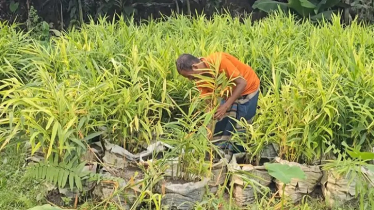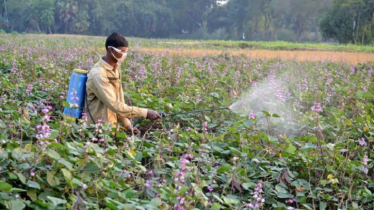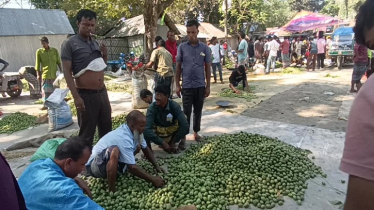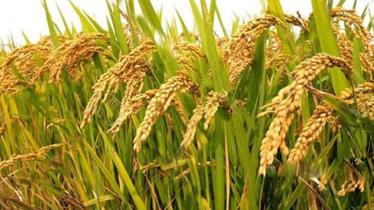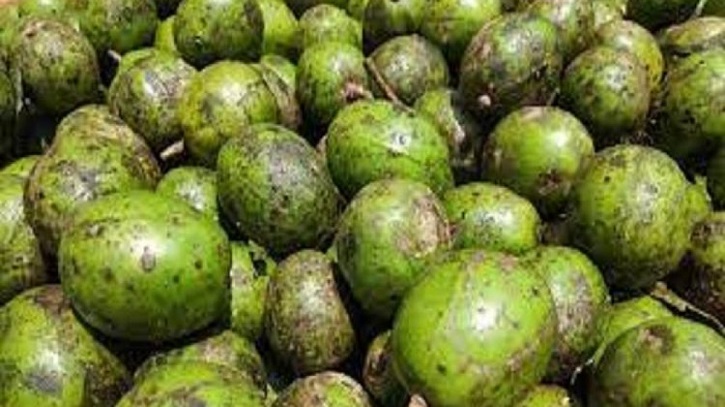
In the canal-surrounded villages of southern Bangladesh, the tangy scent of ambarella now carries the aroma of money. From the floating markets of Jhalakathi, Barishal, and Pirojpur, boatloads of green ambarella are making their way to Dhaka and other major cities. Once a household fruit hanging in the corner of village homes, ambarella has become a major source of income for farmers, fueling an annual trade worth hundreds of millions of taka and reshaping the rural economy of the south — creating what locals call the “green money story.”
In Dhaka, it’s a familiar scene: at red traffic lights, vendors tap on car windows asking, “Sir, would you like some ambarella?” Transparent packets filled with sliced fruit, salt, and chili — sometimes arranged like the petals of a water lily — have become a staple of the city’s streets.
But the roots of this thriving business stretch deep into the waterways of the south. In floating markets like Bhimruli, Atghar-Kuriana, and Jindakathi, hundreds of boats laden with fresh ambarella create a striking spectacle. Throughout the season, the rhythmic calls of buyers and sellers turn the river markets into a bustling hub of trade, marking a new chapter in the region’s agrarian economy.
This year, about 24,000 tons of ambarella have been produced, generating over Tk 1 billion in market value.
Once a humble homestead crop, ambarella is now the symbol of economic prosperity for many southern farmers. Wahidul Islam Hiru, a farmer from Jhalakathi Sadar, said, “About 30 years ago, I planted a few ambarella trees beside my guava orchard. Now I grow 80 to 100 tons of fruit on 20 acres of land, earning over Tk 3 million annually. The price per maund (44 kg) started at Tk 800–900 this season but has risen to around Tk 2,000.”
In Jindakathi village of Swarupkathi, farmer Shubash Mondol shared that replacing guava trees with ambarella has doubled his profit. “Earlier, I earned around Tk 150,000 a year from three acres of guava. Now, with ambarella, I make nearly Tk 300,000. I’ve already replaced more than half my guava trees with ambarella,” he said. Another farmer, Dipak Maitra, reported harvesting 50 maunds of ambarella from one bigha of land, earning Tk 75,000 — more than four times what guava would bring. He added that ambarella trees mature within three years, after which the real profit begins.
Local traders confirm the growing scale of the business. Taposh Bepari, a wholesaler, said that 50–60 major traders from three southern upazilas send 200–300 maunds of ambarella daily to Dhaka and other cities. However, farmers complain that they receive only a fraction of the profit. “Dhaka wholesalers set the prices. We just load our boats and send the fruit. There are no factories or cold storage facilities in our area, so we have to sell at low prices,” said Jhalakathi farmer Nityananda Samaddar.
According to the Bangladesh Bureau of Statistics, the country produced 45,400 tons of ambarella in the 2023–24 fiscal year, with the Barishal division accounting for nearly 40 percent of total production. In Barishal alone, 1,849 hectares of land yielded around 24,000 tons of fruit worth over Tk 1 billion. In Pirojpur, 3,390 farmers cultivated ambarella on 577 hectares, producing more than 10,000 tons valued at Tk 150 million.
Deputy Director of the Department of Agricultural Extension (DAE) in Pirojpur, Md. Mahfuzur Rahman, said that while initial costs are high, they fall to one-third in subsequent years. “Ambarella is less perishable than guava, which is why more farmers are turning to it,” he explained.
In Jhalakathi, 4,578 tons of ambarella were harvested from 602 hectares of land. The district’s DAE Deputy Director, Abdullah Al Mamun, said, “Cultivating ambarella costs Tk 75,000–80,000 per acre but yields up to Tk 190,000 in return. After the fruit received Geographical Indication (GI) recognition, its market value increased even further.”
From the southern riverbanks to the streets of Dhaka, ambarella has transformed from a backyard fruit into an economic powerhouse — a testament to how green produce can turn into green profit.


